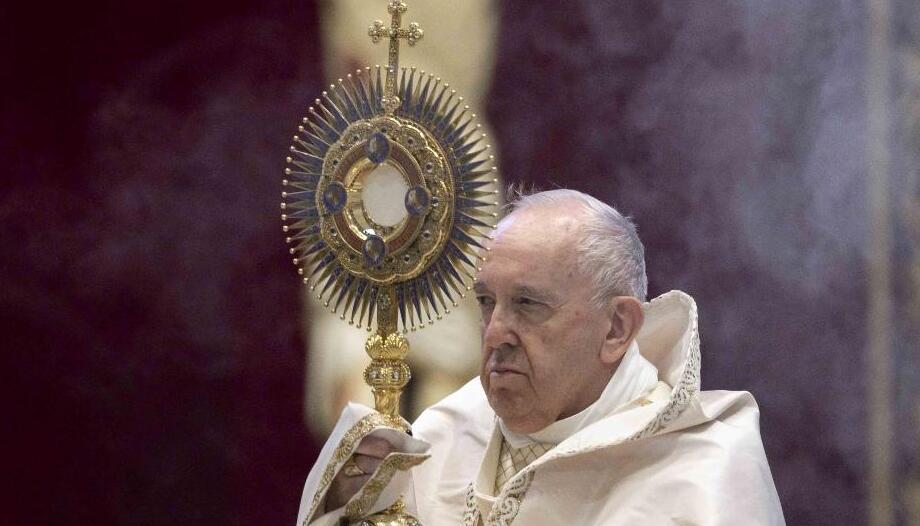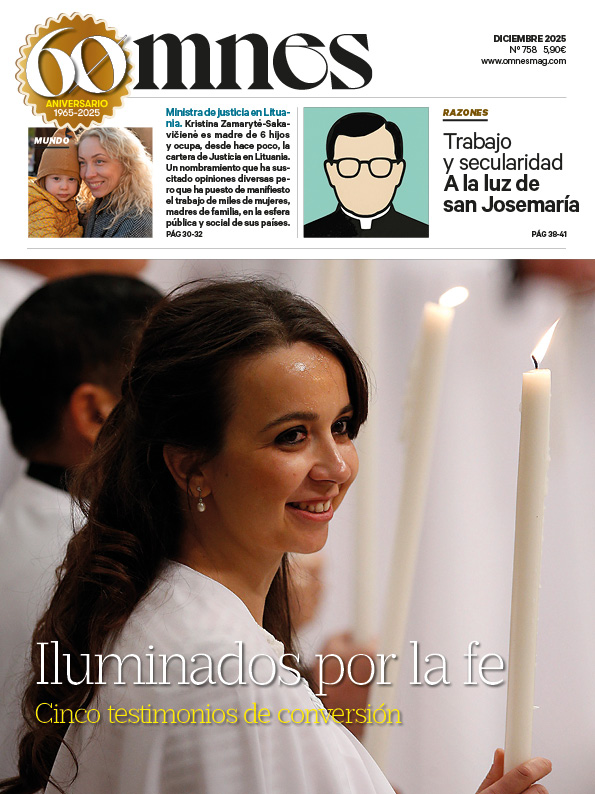The conversion of bread and wine into the Body and Blood of Christ at the moment of consecration, a sacrament instituted by the Lord at the Last Supper, with the command "do this in memory of me", is a central event in the daily life of the Church, as the Popes have recalled, but there have been times when heretical doctrines were spread which affirmed that the presence of Jesus in the sacramental species was symbolic, not real.
In this context, beginning in 1200, in the middle of the 13th century, a series of Eucharistic miracles began to occur, which finally prompted Pope Urban IV to declare the Feast of Corpus Christiof the Body and Blood of Christ, firstly on August 11, 1264, with a bull addressed to the Patriarchate of Jerusalem (occupied by himself before being elected pope), and then a second bull addressed to the entire Catholic world.
Saint Juliana of Liège and distinguished theologians
As the Franciscans of the Custody in the Holy Land emphasize, the motif that inspired the feast originated in Flanders, where in the mid-13th century the Eucharistic movement was already very active against the spread of heresies. At that time, the Belgian nun Saint Julienne de Mont Cornillon (Liège) and other nuns had a series of mystical visions in which the Lord made them understand the absence in the Church of a solemnity in honor of the Blessed Sacrament.
In 2010, the late Benedict XVI referred to St. Julienne of Liège with these words: "I wish to present to you a female figure, little known, but to whom the Church owes great recognition, not only for her holiness of life, but also because, with her great fervor, she contributed to the institution of one of the most important liturgical solemnities of the year, that of Corpus Christi. It is about saint Juliana de Cornillonalso known as Saint Juliana of Liege".
"Juliana was born between 1191 and 1192 near Liège, in Belgium. It is important to underline this place, because at that time the diocese of Liège was, so to speak, a true 'Eucharistic cenacle'. There, before Juliana, distinguished theologians had illustrated the supreme value of the sacrament of the Eucharist and, also in Liège, there were women's groups generously dedicated to Eucharistic worship and fervent communion. These women, guided by exemplary priests, lived together, devoting themselves to prayer and works of charity".
The good cause of the Feast of Corpus Christi, Benedict XVI explained, "also won over St. Pantaleon of Troyes, who had met the saint during his ministry as archdeacon in Liege. It was precisely he who, on becoming Pope under the name of Urban IV, in 1264 wanted to institute the Solemnity of Corpus Christi as a feast of obligation for the universal Church. In the bull of institution, entitled 'Transiturus de hoc mundo' (August 11, 1264) Pope Urban alludes with discretion also to the mystical experiences of Juliana, endorsing their authenticity".
The Sacred Bodies in Luchente and Daroca
It is fair to point out that a few years earlier, and in parallel, on March 7, 1239, the miracle known as the miracle of the Sacred Bodies of Daroca had taken place in Valencian and Aragonese lands, whose historical sequence is recorded in the document of 1340 known as the Letter of Chiva, preserved in the Collegiate Archive of Daroca.
The story was also collected, in 1860, in a study by Tomás Orrios de la Torre, canon of the Collegiate Church of the municipality of Daroca, which has been republished with several appendices, for example in 2014, when it was 775 years since the miracle occurred in Luchente (Valencia) on February 23, 1239. and 750 years since the institution of the feast of Corpus Christi in the universal Church.
The documents accredit to the satiety the miracle of the six consecrated forms that the captains of the Tercios of Daroca, Calatayud and Teruel were going to receive communion, before launching themselves to the conquest of the castle of Chio in Muslim land, and that they could not do it because of an attack of the enemy. The six forms, hastily kept by a priest in a corporal, appeared, when picked up, completely bloodied, without the least explanation in natural terms.
Against all odds, being a minority and under siege, the Christians were victorious in the battle. Those present there understood this event as a miracle, a manifestation of God, in an account recorded in the Letter of Chiva, which Orrios de la Torre collected, and which was also synthesized in the Heraldo de Aragónand other places.
"First Corpus Christi procession".
In addition, the captains of the three companies that intervened in the battle wanted to take the cloth with the bloody hosts to their cities, but the proof of the miracle could only have one destination, and the luck fell on Daroca, because not agreeing on the award, it was arranged that a "blind" mule was put on the road to Christian territory, carrying in a chest the miracle. It passed Teruel, and already in Daroca, the mule stopped at the convent of the Trinitarians, and burst. The sacred forms remained in the church, and it was accepted by all that the Aragonese city should be the custodian of this miracle of Eucharistic faith.
This 14-day walk from Valencia to Daroca has been called "the first Corpus Christi procession", and is narrated by historians of the time. Numerous pilgrims arrived, in addition to those who came from many parts of Europe on their way to Santiago de Compostela.
Later, the Catholic Monarchs ordered the construction of a chapel, and rebuilt what would be one of the first basilicas in Spain with a central transept. It is the current basilica of Santa María de los Sagrados Corporales de Daroca, granted this dignity by Leon XIII in 1890, and called La Colegial.
The Nuncio, in the Corpus Christi of Darocense
In this Darocense temple has taken place last Thursday the celebration of the solemnity Bernardito Auza, Papal Nuncio, and the Archbishop of Zaragoza, Monsignor Carlos Escribano, in the presence of other prelates, priests and numerous faithful who participated in the subsequent procession.
Nuncio Auza recalled in his homily that "from the love that flows from the Eucharist, the bishops invite us to actualize this mystery day by day. Only from the abasement of Love, the mysticism of this sacrament is understood. The Pope tells us: 'You will not achieve with your hands what you do not first meditate on your knees'".
By the way, Daroca already has a relic of the one known as the apostle of the Internet, beato Carlo Acutiswho will be canonized, and who was characterized by a great love for the Eucharist.
The miracle of Bolsena
After Pope Urban IV was elected, two syndics from Darocco went to Rome to inform him of the event, and they were presented by St. Bonaventure and by St. Thomas Aquinaswho were later named patrons of the municipality of Daroca.
As is well known, Saint Thomas Aquinas is the author of the hymn Adoro te devoteHe composed it in honor of the sacramentalized Lord at the request of the Pope, precisely on the occasion of the institution of the feast of Corpus Christi.
This was also the time of the miracle of Bolsena (Italy), in which a consecrated Host was transformed into flesh while celebrating Mass by a priest who doubted the real presence of Christ in the Eucharist. In this case, the sacramental species were inspected by the Pope himself, and reviewed also by St. Thomas Aquinas, as indicated in the eucharistic miracles website of Blessed Carlo Acutis. The relic of this miracle has been in the cathedral of Orvieto ever since.
In various catecheses and addresses over the years, Pope Francis has centered the Church's missionary action on the Eucharist.








